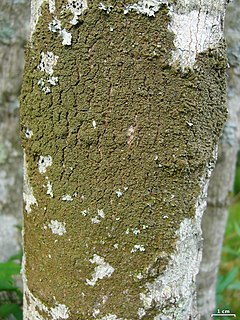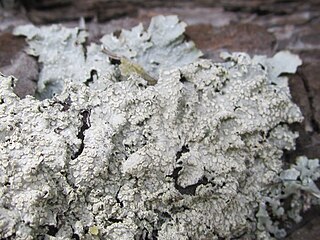
Hypogymnia is a genus of foliose lichens in the family Parmeliaceae. They are commonly known as tube lichens, bone lichens, or pillow lichens. Most species lack rhizines that are otherwise common in members of the Parmeliaceae, and have swollen lobes that are usually hollow. The lichens usually grow on the bark and wood of coniferous trees.

Melanohalea is a genus of foliose lichens in the family Parmeliaceae. It contains 30 mostly Northern Hemisphere species that grow on bark or on wood. The genus is characterized by the presence of pseudocyphellae, usually on warts or on the tips of isidia, a non-pored epicortex, and a medulla containing depsidones or lacking secondary compounds. Melanohalea was circumscribed in 2004 as a segregate of the morphologically similar genus Melanelia.
Bulbothrix meizospora is a species of foliose lichen in the family Parmeliaceae. It is found in Africa, Asia, and South America, where it grows on tree bark.
Hypogymnia pseudopruinosa is a species of foliose lichen in the family Parmeliaceae, and one of more than 40 species of the genus Hypogymnia that is found in China. It was formally described by Xinli Wei and Jiangchen Wei in 2006. The type was collected from dead branches of Juniperus sabina, in Degen County (Yunnan), at an altitude of 4,100 metres (13,500 ft). It is quite similar in appearance to Hypogymnia macrospora, but that species lacks the dense layer of pruina that is characteristic of H. pseudopruinosa.
Hypogymnia laxa is a species of foliose lichen in the family Parmeliaceae. Found in the Chinese Himalayas, it was described as a new species by Bruce McCune in 2003. The type specimen was collected from the Jiaozi Snow Mountain in Luquan County (Yunnan), at an elevation of 3,750 metres (12,300 ft). Here it was found growing on the bark and wood of Abies, Pinus, and Rhododendron. The lichen is characterized by a thallus with soredia, the presence of physodalic acid in the medulla, and rimmed holes on the lower surface. This latter feature distinguishes it from the morphologically similar Hypogymnia pseudophysodes, which always has unrimmed holes.
Hypogymnia pseudocyphellata is a rare species of foliose lichen in the family Parmeliaceae. Found only in the Chinese Himalayas, it was described as a new species by Bruce McCune and Erin Martin in 2003. The type specimen was collected from the Tian Chi alpine lake in Shangri-La City (Yunnan), at an elevation of 3,750 metres (12,300 ft). Here it was found growing on the bark and wood of fir. The lichen is characterized by the presence of whitish pseudocyphellae on the tips of the lobes ; rimmed holes; lobes that are narrow and separated; and a complex secondary chemistry with several unknown chemical compounds as well as barbatic acid, but without diffractaic acid.
Hypogymnia diffractaica is a species of foliose lichen in the family Parmeliaceae. Initially reported from Southwest China, it was described as a new species by Bruce McCune in 2003. The type specimen was collected in Jiulong County, at an elevation of 3,000 metres (9,800 ft). Here it was found growing on the bark and wood of Rhododendron; it has also been recorded on birch. It is characterized by its slender lobes, the rimmed holes on the lower surface, and the presence of the chemical diffractaic acid as the main secondary metabolite in the medulla. It has a lower surface that is expanded and puffed out. Hypogymnia hengduanensis, the only other Hypogymnia species containing diffractaic acid as the main medullary substance, is quite similar in appearance, but can be distinguished from H. diffractaica by the presence of isidia. It also tends to grow at slightly lower elevations. In 2018, H. diffractaica was recorded from Bhutan.
Hypogymnia congesta is a rare species of foliose lichen in the family Parmeliaceae that is found in China. It was formally described as a new species by Bruce McCune and Chicita Culberson in 2003. The type specimen was collected near Wei Den village, behind Lou Ma Deng Mountain in Weixi County (Yunnan), at an elevation of 3,000 metres (9,800 ft). There it grows on the bark and wood of conifers and bamboo. Hypogymnia congesta has a brown to brownish-grey foliose thallus measuring up to 8 cm (3.1 in) long or broad, with a cartilage-like texture. Its ascospores measure 7–8 by 5.0–5.5 μm. The lichen is chemically distinct, containing virensic acid and physodic acid, but lacking physodalic acid. Virensic acid is otherwise unknown from the genus Hypogymnia.
Hypogymnia bulbosa is a species of foliose lichen in the family Parmeliaceae. Found in Southern China, it was described as a new species by Bruce McCune and Li-Song Wang in 2003. The type specimen was collected from the Zi ben Mountain in Cao County (Yunnan). There it was found growing on a spruce stump. It has also been recorded growing on the bark and wood of fir, willow, and Rhododendron. It is known to grow at elevations ranging between 2,800–3,800 metres (9,200–12,500 ft), generally in conifer forests. The lichen is characterized by features such as the rimmed holes on the lower surface of the thallus, the presence of the chemical physodalic acid, and the adundant budding.
Punctelia ruderata is a species of foliose lichen in the family Parmeliaceae. It is a member of the Punctelia rudecta species complex. Found in Asia and East Africa, it was first formally described as a new species in 1921 by Finnish lichenologist Edvard August Vainio as Parmelia ruderata. The type was collected by Atsushi Yasuda in Honshu, Japan, where it was found growing on tree bark. The lichen was reported from South America in a 2009 Ph.D. thesis, and the taxon transferred to the genus Punctelia. The new combination, however, was not validly published, and molecular phylogenetic analysis showed that the species does not occur in Brazil. The name was resurrected and validly published in 2016.
Punctelia ulophylla is a species of foliose lichen in the family Parmeliaceae. It is found in Europe, where it grows on the bark of a variety of trees.
Punctelia pseudocoralloidea is a species of foliose lichen in the family Parmeliaceae. It is found in Australia, where it grows on bark and on wood.

Punctelia perreticulata is a widely distributed species of foliose lichen in the family Parmeliaceae. It occurs in Mediterranean Europe and Russia, North America, South America, Australia, and New Zealand, where it grows on rocks, bark, or wood. Its main distinguishing features are its thallus surface, marked with many shallow depressions, grooves, or pits, and sorediate pseudocyphellae. The lower side of the thallus is ivory to tan towards the centre and the major secondary metabolite in the medulla is lecanoric acid. A lookalike species with which it has been historically confused is Punctelia subrudecta; this lichen can be distinguished from Punctelia perreticulata by the texture of the thallus surface, or, more reliably, by the length of its conidia.

Hypogymnia krogiae, commonly known as the freckled tube lichen, is a species of foliose lichen in the family Parmeliaceae. Found in North America, it was described as a new species in 1973 by Karl Ohlsson. The type specimen was collected near Cheat Bridge, West Virginia by Mason Hale in 1956.

Hypogymnia flavida is a species of foliose lichen in the family Parmeliaceae. It is found in mountainous locations of east Asia, where it grows on the bark and wood of woody plants. It has a relatively large yellowish thallus.
Menegazzia hypogymnioides is a species of foliose lichen in the family Parmeliaceae. Found in Australia, the species was described as new to science by Australian lichenologist Gintaras Kantvilas in 2012. The type specimen was collected from Clear Hill, Tasmania, at an altitude of 1,190 m (3,900 ft), where it was growing on conglomerate boulders in alpine heath. The specific epithet refers to its similarity to a small species of Hypogymnia. It is a very rare species that occurs only at high elevations in southwestern Tasmania, typically in sheltered habitats.
Hypogymnia wilfiana is a species of foliose lichen in the family Parmeliaceae. It is found in western North America, where it grows on conifer trees.
Hypogymnia australica is a species of foliose lichen in the family Parmeliaceae. Found in Australia, it was formally described as a new species by lichenologist John Elix in 1989. The type specimen was collected from the Great Dividing Range in New South Wales at an altitude of 850 m (2,790 ft). Here it was found growing on a species of Leptospermum.
Hypogymnia papilliformis is a rare species of foliose lichen in the family Parmeliaceae. Found in China and the Russian Far East, it was formally described as a new species in 2015 by Bruce McCune, Svetlana Tchabanenko, and Xin Li Wei. The type specimen was collected by the second author in the Lazovsky Nature Reserve at an altitude of 600 m (2,000 ft); here, in a mixed conifer–broadleaved forest, it was found growing on Korean pine. The lichen has also been recorded from a mixed forest in the mountains of Shaanxi Province in China, at an altitude of 1,500 m (4,900 ft). The specific epithet papilliformis alludes to the papillose texture of the upper thallus surface. Secondary compounds that occur in Hypogymnia papilliformis include atranorin, and physodic acid as major metabolites, and minor amounts of 2'-O-methylphysodic acid and vittatolic acid.
Anzia pseudocolpota is a species of corticolous (bark-dwelling), foliose lichen in the family Parmeliaceae. Found in southwestern China, it was formally described as a new species in 2015 by Xin-Yu Wang and Li-Song Wang. The type specimen was collected by the second author from Lidiping mountain at an altitude of 3,350 m (10,990 ft), where it was found growing on Loranthus bark. It is named for its similarity to Anzia colpota, from which it differs by the presence of a central axis, a discontinuous spongiostratum, and the presence of the lichen product divaricatic acid. The lichen is only known to occur in Sichuan and Yunnan, at elevation ranges between 2,500 and 3,700 m.




